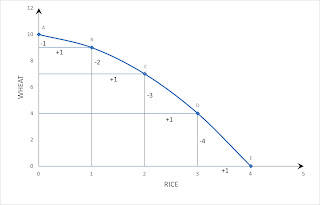When we look at the shape of the PPC, we find that it curves inward or in other words, it is concave to the origin.
Why is the PPC Concave to Origin?
The PPC is concave because it has an increasing slope. This means for every additional unit of rice to be produced, more and more of wheat needs to be sacrificed i.e., for every increase in the production of rice, the quantity of wheat given up is increasing.
|
Combination |
Units of Wheat |
Units of Rice |
|
A |
10 |
0 |
|
B |
9 |
1 |
|
C |
7 |
2 |
|
D |
4 |
3 |
|
E |
0 |
4 |
When a nation moves from a combination A to B, it is giving up 1 unit of wheat to gain 1 more unit of rice, moving from a point B to C means losing 2 units of wheat for increasing a unit of rice, point C to D shows 3 units of wheat have to be sacrificed to get an additional unit of rice.
Why does the PPC have an Increasing Slope?
This happens because resources are use-specific or resources may not be equally efficient for the production of different goods.
For example, a piece of land in Northern part of India is more suitable for the production wheat than rice, as the temperature and soil conditions are more suitable for the production of wheat than rice. Hence, ideally that piece of land in Northern India would produce more wheat than rice. Therefore, if the nation desires to increase the production of rice, more efforts are needed compared to the production of wheat.
So, for every extra unit of rice to be produced, more and more of wheat has to be given up. When we move from a point A to B, to increase the production of rice by 1 unit, the production of wheat decreases by a unit. Now, when we want to move from a point B to C, an additional unit of rice would require the transfer of the more efficient resources from the production of wheat to the production of rice. Hence, that leads to fall in wheat by a greater amount than before. There is a decrease in the production of wheat by 2 units. If we now, want to move to a point C to D, it would require transfer even more efficient resources from the production of wheat to the production of rice, leading to again a greater fall in wheat than before. The production of wheat further decreases by 3 units.
Thus, the slope
of the curve (which is measured by the loss of production of wheat divided by
the gain in the production of rice when we move down the curve) is increasing at
each point as we move down on the PPC. This increasing slope gives rise to the
concave shape of the PPC.
Hence, PPC is concave because it has an increasing
slope or the Marginal Rate of Transformation (MRT) is increasing at every point
as we move down on the PPC.
- The PPC is concave because it has an increasing slope, that means for every additional unit of one good to be produced more and more of the other good needs to be sacrificed.
- This happens because resources are use-specific or resources may not be equally efficient for the production of different goods. So, for every extra unit one good to be produced, more and more of the other good has to be given up.
